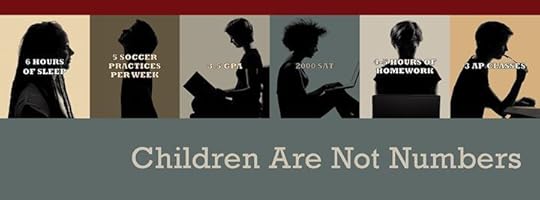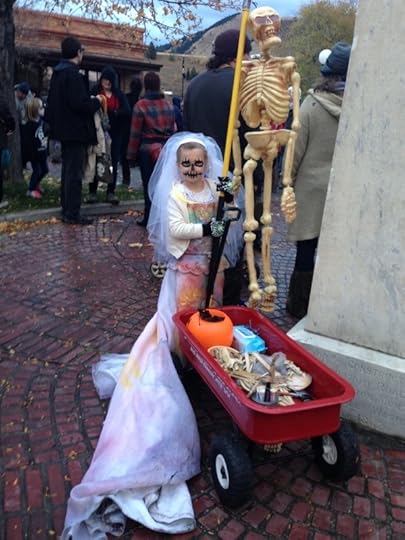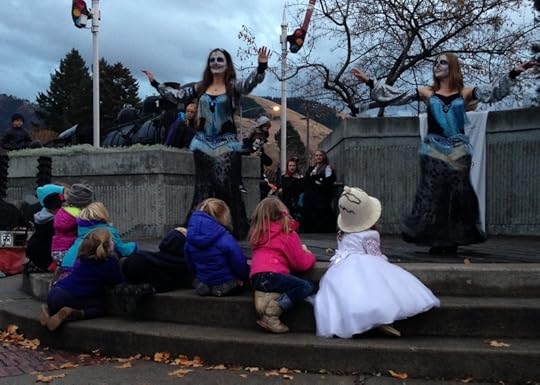Karen Buley's Blog, page 5
October 19, 2014
An Evening at ROOTS Young Adult Shelter
During my recent visit to Seattle, I had the privilege of volunteering at ROOTS (Rising Out Of The Shadows) Young Adult Shelter. Its mission statement reads: ROOTS provides shelter and other essential services to homeless young adults. We build community, advocate for social justice, and foster dignity among low-income people.
ROOTS provides a safe place for up to forty-five young adults, ages eighteen to twenty-five, 365 nights a year. The night I volunteered, there wasn’t enough space to accommodate all who sought shelter. According to ROOTS’ website, this has become a more common occurrence. “These young people are spiraling out of the foster care system and onto the streets, fleeing abusive homes and failing to find work opportunities to survive in this tough economic climate.”
Those who weren’t lottoed in that night were given a plate of food, a blanket, a bus ticket, and a referral to another shelter if space was available. Of the guests in shelter, their resilience and unfulfilled potential were palpable. Some were students. Others were employed. But none had stable homes.
I helped two other volunteers prepare dinner. Though it was their second night at shelter, it was their first night on kitchen duty. We prepared a “feast” using leftovers, salad, fruit, baked goods, and four packages of egg noodles which we added to gorgonzola cheese sauce we scored from the refrigerator.
While we were preparing the meal, some folks carried in leftovers from a group gathering. Since we had plenty of food, we dated their donations and put them in the refrigerator, where they were sure to be a welcome discovery for the dinner crew the following night.
In addition to the above, several things struck me about my evening at ROOTS.
The dedication of staff and volunteers.
Preferred gender pronouns on staff and volunteers’ nametags.
An on-site resource specialist.
Donated clothing and books.
A sign which said that you could not use on-site, but if you arrived with dirty needles, they could be disposed of safely.
The smooth transition of the room as guests helped arrange mats and bins.
Guest access to computers, laundry facilities, showers, and lockers.
The camaraderie between volunteers and guests.
The politeness and appreciativeness of the guests.
The opportunity for guests to earn locker privileges by volunteering in shelter.
The serenity of the room and its forty-five guests after lights out.
Our opening meeting before guests arrived and our debriefing after lights out were impressive. I was moved by the compassion and commitment of the volunteers, several of whom were in the age group of the guests.
During our debriefing, we were given the opportunity to share concerns, warnings given, and an evening highlight. No one had warnings or concerns, but we all had highlights. One volunteer, whom we learned in our opening meeting was there for the first time, was enthusiastic about her desire to return. Others were regulars, evident by nods of recognition as they shared highlights about familiar guests.
When it was my turn, I shared three highlights: being part of a team headed by my son Eric, the evening’s Program Coordinator; seeing the welcoming, safe, inclusive place I’d heard so much about; and having guests help in the kitchen and in the dish room.
I didn’t share one huge highlight though, afraid tears would stifle my words. Working with my kitchen companions, and peripherally with the other volunteers, was deeply moving. To witness their kindness, compassion, dedication and connectedness with the guests was an affirmation of the goodness in our world. I wanted to tell them that they’re making our world a better place. I wanted to say that being in their presence made my heart sing, but I knew I would choke on my words.
I was touched by the guests as well. Through my observations and brief interactions with some of them, I felt so much unfulfilled potential. Two poignant memories stand out. As I was preparing a burrito for a guest, another awaiting his dinner asked, “How’s your night going?” I told him it was going well and asked how his was. “Pretty good,” he said. “That’s what we always say. Pretty good,” he repeated, with a hint of a smile.
What resilience.
Later, Eric had just given me a quick introduction to the dish room and sterilizer when a guest arrived and donned an apron. Wordlessly he turned his back to me and held out his apron strings for me to tie. Eric asked if he wanted help with the dishes but the guest said no, so I went back into the kitchen to collect our serving dishes.
After adding them to the overflowing counter, I thanked our helper for tackling the mountain of dishes. He said he’d done “twenty times that many” and told me he used to work in a restaurant. When I asked where, he hesitated. I’d wondered then if, in my attempt at small talk, I’d overstepped my bounds. He allayed my fear seconds later when he said in a soft voice, “Colorado.”
What a tender moment to be gifted with his trust.
Thank you, ROOTS, for the important work you do. Thank you for providing a safe, welcoming and inclusive place and for being a stepping stone as you raise young adults out of the shadows.
 Tags: compassion, dignity, Eric, homeless, resilience, ROOTS, Seattle, shelter, social justice, young adults
Tags: compassion, dignity, Eric, homeless, resilience, ROOTS, Seattle, shelter, social justice, young adultsDel.icio.us


TweetThis

Digg

StumbleUpon

Comments: 0 (Zero), Be the first to leave a reply!
You might be interested in this:
 Thank You for Your Service
Thank You for Your Service 2013 Montana Festival of the Book
2013 Montana Festival of the Book The Kindle Version is Here
The Kindle Version is Here The Power of Observation
The Power of Observation The International Choral Festival Copyright © Karen Buley [An Evening at ROOTS Young Adult Shelter], All Right Reserved. 2014.
The International Choral Festival Copyright © Karen Buley [An Evening at ROOTS Young Adult Shelter], All Right Reserved. 2014.August 26, 2014
Mindfulness
(mīn(d)-fəl-nəs) n. the quality or state of being mindful; the practice of maintaining a nonjudgmental state of heightened or complete awareness of one’s thoughts, emotions, or experiences on a moment-to-moment basis
www.merriam-webster.com
 The importance of being mindful hit home in a painful way a couple of months ago. The instant I put in my contact lens, I realized my mistake. Instead of applying wetting solution, I’d reapplied cleaning solution. The stuff that carries a bold printed warning: Not for use in the eye, cleaner could damage the eye.
The importance of being mindful hit home in a painful way a couple of months ago. The instant I put in my contact lens, I realized my mistake. Instead of applying wetting solution, I’d reapplied cleaning solution. The stuff that carries a bold printed warning: Not for use in the eye, cleaner could damage the eye.
I struggled to get my contact out. I don’t know if the thoughts racing through my mind made my fingers less nimble, or if the soapy solution created more suction than usual on my gas permeable lens, but it took too long to pop it out. Fifteen seconds, give or take. Fifteen seconds, magnified tenfold.
To make matters worse, we were in Brazil. The nurse in me knew that I needed to rinse my eye for fifteen minutes. We’d been advised not to drink the tap water and, though no one had said anything about using it as an eye rinse—who would’ve thought—it didn’t seem like the best idea. But we were nearly out of bottled water, so I rinsed with tap. Two minutes, max. In part because rinsing made my eye hurt worse. In part, too, because I wondered if something in the “do-not-drink-the-water” might be equally damaging to my eye.
I asked my son Colin to look up “contact cleaner in eye” on the internet, unsure if I needed to scout for a place to have a Sunday morning eye exam. His sleuthing was reassuring, so I grabbed money and my pocket English-Portuguese dictionary and headed to a nearby pharmacy.
On the way, I heard someone calling my name, and was joined by two Daves, fellow Missoulians en route to the supermarket. Dave K. accompanied me to the pharmacy, his English-Portuguese phone app at the ready. The pharmacist, who didn’t speak English but who had bailed me out days earlier when I’d shown her the word nausea, nodded when, this time I pointed to eye drops. I hadn’t expected to find that in my little dictionary. But there it was.
After she handed me sulfacetamide drops—prescription medication in the U.S.—I tipped my hand above my eye and asked, “Água?” Reaching over the counter, she pointed to eight-ounce bottles of saline. Thinking that bottled water might hurt less, I paid for the eye drops, then Dave and I continued on to the neighboring supermarket—I to buy water, he to buy water and a snack for his teenaged son.
I did a second rinse with the bottled water when I returned to our apartment. It hurt as much as the first, so I kept it equally short. My eye had watered nonstop since its cleaning solution assault, so I hoped my abbreviated rinse, coupled with the tears, would be adequate. I followed the rinse with eye drops, which I continued to use three or four times each day, even though inching that bottle toward my eyeball gave me the willies.
I wore my glasses for days; the swelling resolved; and, true to Colin’s internet research, I didn’t suffer permanent eye damage.
My take-home lesson? Be present.
 I had a chance to practice on our way home when our Chicago flight was delayed. Our departure time changed three times as 9:47 a.m. morphed into 12:27 p.m.. I walked, had a bowl of chicken tortilla soup, and perused a display of self-improvement books. Summing up the lesson I learned the hard way in Salvador? A quote I discovered in Frank J. Kinslow’s Beyond Happiness: Finding and Fulfilling Your Deepest Desire, “The mind set firmly on the present is at rest.”
I had a chance to practice on our way home when our Chicago flight was delayed. Our departure time changed three times as 9:47 a.m. morphed into 12:27 p.m.. I walked, had a bowl of chicken tortilla soup, and perused a display of self-improvement books. Summing up the lesson I learned the hard way in Salvador? A quote I discovered in Frank J. Kinslow’s Beyond Happiness: Finding and Fulfilling Your Deepest Desire, “The mind set firmly on the present is at rest.”
 Tags: books, Brazil, Colin, contact lenses, eyes, mindfulness, Missoulians, nurses, Salvador
Tags: books, Brazil, Colin, contact lenses, eyes, mindfulness, Missoulians, nurses, SalvadorDel.icio.us


TweetThis

Digg

StumbleUpon

Comments: 0 (Zero), Be the first to leave a reply!You might be interested in this:
 2014 Big Sky Documentary Film Festival
2014 Big Sky Documentary Film Festival Nursing and Books
Nursing and Books Festival of the Dead: a Time to Remember
Festival of the Dead: a Time to Remember World Book NightCopyright © Karen Buley [Mindfulness], All Right Reserved. 2014.
World Book NightCopyright © Karen Buley [Mindfulness], All Right Reserved. 2014.July 13, 2014
World Cup 2014
Brazilians love their futbol. O jogo bonito, they call it. The beautiful game. I had the good fortune of witnessing this love firsthand when, topping my husband’s bucket list, World Cup 2014 drew our family to Salvador, Brazil.
Truth be told, though I was looking forward to seeing some games, I was more excited about spending time with our sons, Eric and Colin. Living five hundred miles apart, our opportunities to get together are limited. Anticipating more than three weeks of family bonding had me over the moon.
What I hadn’t envisioned—something zealous soccer fans will have a hard time understanding—is just how electrifying it would be. To be. In Brazil. For the World Cup.
I’m no stranger to soccer. Rich and I began playing in our mid-twenties and, years later, I became a soccer mom. That status segued the summer of 2010 when our family played together on a co-rec team. Playing short one sweltering July evening, I was assigned to midfield. I still smile at the memory of Colin hollering, “MOM! GO TO THE BALL!” O jogo bonito it was not.
Fast-forward to June, 2014. In the preparatory reading I did on the plane, I learned new—to me—soccer terms. Matches. Penalties. Pitch. Set plays. I read about the World Cup groups, teams, and star players. I learned that, after sixty-four years, Brazil’s devastating 1950 World Cup loss to Uruguay—coined el Maracanaço, the Maracanã blow—remained an open wound. A 2014 Brazil World Cup victory at Estádio do Maracanã could erase the lingering sorrow.
As we queued with hundreds of others to watch the opening match at Salvador’s FIFA Fan Fest, the excitement was palpable. Brahma flowed; drum beats, cheers, and vuvuzelas created a cacophony of noise; Brasil’s yellow and green ruled the night; and the home team won. It was magical.
Throughout the ensuing days, the air sizzled as futbol reigned supreme. Soccer jerseys, flags and team colors led to conversations among strangers—filled with either pre-match anticipation and speculation, or post-match jubilation or angst. Whether watching a match at our pousada, in a restaurant, at the Fan Fest, or live at Arena Fonte Nova, it was a treat to gather with others—including more than fifty thousand in the Arena—and be a part of the ebb and flow of groans and cheers, high fives and stadium waves.
Before the France vs Switzerland match, I crafted a rudimentary sign, hoping to connect with our French student, Jordane, across the airwaves. Approaching the stadium, I was on a mission to score face paint to increase my odds. I spotted a young woman painting flowers on her cheeks—mirror in one hand, brush in the other. A young man, whose entire face was painted blue, white and red, supervised her handiwork. They were Brazilians, I learned, supporters of Esporte Clube Bahia, the local team which shares the French colors. As the woman interrupted her artistry to finger paint two flags for me, I told them our French friend was hoping to see us on TV. Her friend laughed and, carefully sandwiching his face between his hands, said, “I want to be on TV, too!”
I hope he was successful.
Television cameras did not swing our way during the game. Outside the stadium, though, Colin and I hurried to a random camera to wave my sign and cheer France’s victory. Perhaps someone—somewhere—saw us, but we did not receive reports of a sighting from anyone we knew.
Added sweetness to our World Cup adventures included being joined by twenty-four other Missoulians three days before USA played Belgium in the Round of 16. In Salvador. On game day, Rich, Colin and several of the Missoula crew bused to the Pelourinho, the Historic Centre, where they found a dance-club-turned-game-watching-venue to watch Argentina beat Switzerland.
Joined by a group of boisterous Belgians, there was playful bantering regarding the anticipated outcome of the USA vs Belgium match. Many of the Missoula fans shared a confidence that the US would triumph.
Dressed for victory, a faction of Missoulians was interviewed by Norwegian and Ukrainian television stations before the match, and by NBC and BeIN Sports after. ESPN captured them on camera, too; later replaying their enthusiasm on Sports Center.
But a victory was not to be had.
Still, it was thrilling to see the US play. Watching them, and witnessing Tim Howard’s record-breaking sixteen saves in a World Cup match, was priceless. They played a hard-fought battle and, though they lost, USA deserves a thumbs up for making it to the Round of 16.
The Belgium team deserves a thumbs up as well. Their fans’ cheers permeated the stadium at the end of overtime as they reveled in their team’s success. Not wanting to watch their post-game celebration, we scooted to the exit.
As we made our way through the Pelourinho, a Brazilian woman stopped Eric and me. “She wants to talk to you,” she said, gesturing to the school-aged girl beside her.
“I just want to say,” the girl said in a quiet voice, “that I’m mad that we lost, but I think we’ll win the next World Cup.” She lived in California, she told us, and the woman, her aunt, lived in Salvador. Her mom had watched the game with them, too, “but she’s over there,” she motioned. “She’s mad.” We ended our conversation with smiles and a shared hope for a 2018 USA victory.
Two blocks later, we were stopped again in the Praça da Sé. A reporter asked Eric if she could interview him for TeleSUR, a Venezuelan news station. Serendipitous, since Eric had worked in Venezuela a few years ago. The reporter asked him to add my USA scarf to his inconspicuous blue shirt, then the camera rolled.
Throughout our stay, I watched people from all around the world come together, and I witnessed how quickly a smile or a thumbs up transcended language barriers. A special thumbs up for Joseph Santini, proprietor extraordinaire, and his entire staff of the Pousada Manga Rosa, Portal do Mar Restaurante, and Dolce Vita Pizzaria. They love their futbol. And I feel their pain.
 Tags: Arena Fonte Nova, Brazil, Colin, Eric, FIFA Fan Fest, futbol, Joseph Santini, Missoulians, mothers, Rich, Salvador, World Cup 2014
Tags: Arena Fonte Nova, Brazil, Colin, Eric, FIFA Fan Fest, futbol, Joseph Santini, Missoulians, mothers, Rich, Salvador, World Cup 2014Del.icio.us


TweetThis

Digg

StumbleUpon

Comments: 0 (Zero), Be the first to leave a reply!You might be interested in this:
 Festival of the Dead: a Time to Remember
Festival of the Dead: a Time to Remember Our Introduction to the Big Sky Documentary Film Festival
Our Introduction to the Big Sky Documentary Film Festival Nanny on the Run is Launched!
Nanny on the Run is Launched! 2013 Montana Festival of the Book
2013 Montana Festival of the Book World Book Night 2013Copyright © Karen Buley [World Cup 2014], All Right Reserved. 2014.
World Book Night 2013Copyright © Karen Buley [World Cup 2014], All Right Reserved. 2014.May 29, 2014
The Power of Observation
(äb-zər-vā’-shən) n. the act, practice, or power of noticing
Webster’s New World Dictionary: Third College Edition
Recently, some of my Hellgate High School colleagues and I hiked Blue Mountain in search of wildflowers. Our trek held particular significance as we looked for pasque flowers in memory of two beloved staff members who had passed away in the preceding months.
Darcy, one of our biology teachers, had scouted Missoula’s hillsides days earlier. Though rain threatened and the weather forecast called for scattered thundershowers the afternoon of our scheduled hike, we set out. The flowers our attendance clerk extraordinaire, Candice, had loved were in bloom, and we didn’t want to miss them.
 Big Sky Country
Big Sky CountryWe laughed as, battling through a swarm of gnats en route to a patch of pasque flowers, we felt Candice’s playful presence.
 Pasque Flowers
Pasque Flowers Arrowleaf Balsamroot
Arrowleaf Balsamroot Bluebells
Bluebells Missoula Valley
Missoula ValleyLater, after toasting Candice and Lisa, I marveled again at the observational skills of my fellow hikers as we rattled off names of sixteen different plants they’d identified. Though several of the flowers had yet to bloom, leaves were clue enough for some of our wildflower sleuths.
The hikes I’ve taken since that afternoon have been with my senses heightened. I’ve spent more time reflecting on the beauty of this place I’ve lived—and often taken for granted—for the past thirty-six years. Springtime in Montana is good for the soul. It’s good for the mind, too, in a way I hadn’t realized until I read a recent magazine article.
“Pattern recognition is one of my strengths as an investor,” hedge fund founder Renée Haugerud said in the Spring 2014 issue of Montanan. “I think every lesson in trading you can learn from nature.”
So head for the hills. Trillium, glacier lily, clematis, lady’s slipper, Indian paintbrush, everlasting, columbine and arnica are calling your name.
Photos courtesy of Lee Brown
 Tags: Hellgate High School, Missoula, observation, Renée Haugerud, wildflowers
Tags: Hellgate High School, Missoula, observation, Renée Haugerud, wildflowersDel.icio.us


TweetThis

Digg

StumbleUpon

Comments: 0 (Zero), Be the first to leave a reply!You might be interested in this:
 Forty Years Later
Forty Years Later You Can't Win if You Don't Try
You Can't Win if You Don't Try Race to Nowhere
Race to Nowhere Thank You for Your ServiceCopyright © Karen Buley [The Power of Observation], All Right Reserved. 2014.
Thank You for Your ServiceCopyright © Karen Buley [The Power of Observation], All Right Reserved. 2014.April 29, 2014
World Book Night 2014
It was delightful to give away twenty copies of Jamie Ford’s Hotel on the Corner of Bitter and Sweet on World Book Night 2014. At times, I was reminded of Renée Zellweger’s line in Jerry Maquire, “You had me at ‘hello,’” when I began my elevator pitch with, “Today is World Book Night and I have free books.”
I wish I could’ve captured the expressions of the Hellgate High School students’ and recorded snippets as they listened and responded to my pitches. “I’ve heard about this book,” one boy said. “He had to wear a button that said, ‘I am Chinese,’ didn’t he?”
Another said, “I love this book!” adding, “I have a copy,” which freed the remaining book for one of his friends.
Along with a brief chat about Hotel, I told the students that Jamie lives in Great Falls (one hundred seventy miles away) and that “he’s a big deal”—having recently traveled to cities across the U.S., Italy and Norway with his newest book, Songs of Willow Frost. I told them he was in Missoula last fall for The Festival of the Book and I had the pleasure of meeting him.
Some were duly impressed.
They laughed when they heard about Jamie’s “Houdini” dog, Dexter, and the YouTube video that had garnered more than twenty-seven thousand views. In the ensuing days, Dexter has become even more famous. As of today, his viewing audience has escalated to 40,670.
For those I didn’t capture at “Hello,” something in our conversations closed the sales for most of the students I encountered that afternoon. Once books were in hands and I’d received permission to take and post photographs, I took out my camera. For the third year running, my favorite part about being a World Book Night giver?
The smiles.
— Jamie Ford (@JamieFord) April 24, 2014
@karenbuley These kids will obviously rule the world some day! — Jamie Ford (@JamieFord) April 24, 2014
Jamie penned a letter two weeks ago, though I didn’t discover it until yesterday. To those who received a copy of his book, this letter’s for you. To those who did not, read it anyway. His letter—and the above tweets—prove what a cool guy Jamie really is.
 Tags: authors, books, Hellgate High School, Jamie Ford, World Book Night
Tags: authors, books, Hellgate High School, Jamie Ford, World Book NightDel.icio.us


TweetThis

Digg

StumbleUpon

Comments: 0 (Zero), Be the first to leave a reply!You might be interested in this:
 Our Introduction to the Big Sky Documentary Film Festival
Our Introduction to the Big Sky Documentary Film Festival Thank You for Your Service
Thank You for Your Service Inspiration
Inspiration Happy Library Lovers' Month
Happy Library Lovers' Month National Day of ServiceCopyright © Karen Buley [World Book Night 2014], All Right Reserved. 2014.
National Day of ServiceCopyright © Karen Buley [World Book Night 2014], All Right Reserved. 2014.March 31, 2014
Race to Nowhere
Missoula held a screening of “Race to Nowhere” during the Replace the Race Nationwide, March 2014 campaign, thanks to the Missoula Forum for Children and Youth, MCCHD Suicide Prevention, MCCHD Tobacco Prevention, Potomac School District No. 11 and United Way of Missoula County.
This powerful documentary about our education system and its challenges presented much food for thought. As I sat in the darkened theater, I was moved by the film and its message and jotted down the following:
The Blessing of a Skinned Knee
Six hours of homework a night. Plus soccer.
Looks good for colleges.
He is all about learning to take tests.
People get caught up in the race to nowhere.
Kids are our leaders. Without creativity, they are not going to be prepared to lead us.
Play is a critical part of a child’s growing mind and growing body.
Blue Man Group founder: “Why can’t we have happiness as important a metric as reading skills?”
What does it take to produce a happy, motivated, creative human being?
“If every day there wasn’t homework, he would love school.” Mother of a 4th grader (in response to a special “no homework” day).
Nobody knows me at all.
Stanford’s Denise Pope’s Challenge Success Facebook page.
Catching up or leading the way.
U.S. has never led the world in scores.
There were numerous gut-wrenching comments I didn’t write down. A fourth grader talking about stress-induced stomach aches. A high school student saying she didn’t eat because, by not eating, she could concentrate so much better. Conversations about drug use—Adderall to stay up, sedatives to come down; about cutting; about not sleeping, or sleeping only a few hours; about over-scheduled students of all ages; about suicide; about stress-related ER visits and hospital admissions; and about teacher burnout. It was heartbreaking to hear passionate, skilled educators speak about the pressures to teach toward test results, critical thinking skills be damned. Sadly, but understandably, our system is pushing some of these educators out.
Students spoke about the stresses imposed upon them by parents, by teachers, by the pursuit of admission to “top schools.” I was reminded of a conversation I had with my younger son at the beginning of his sophomore year. “Why don’t you join Key Club? It’d look good on college applications,” I said, certain the latter would be a selling point. He replied, “How many times are you going to tell me that?” I made a silent pledge that would be the last.
And it was.
According to a recent Washington Post article, “Local [McLean, VA] school board representative Jane Strauss says she is routinely contacted by parents asking how to prepare their 2-year-olds for a test to get into the Advanced Academic Program for gifted students in third grade.”
Is this what we want for our kids?
I don’t think so.
I do know this. When seniors come into our high school library to get signed off this June, I won’t be asking, “What’s on your horizon?” I don’t want them to think I’m assigning values to their lives-beyond-high-school. And whether they’ll be taking time off; joining the workforce; or going to a community college, a state-funded university, a private or an Ivy League school; my wish for them will be the same. “Congratulations. Take good care.”
 Tags: critical thinking, education, films, parents, Race to Nowhere, stress, students, teachers
Tags: critical thinking, education, films, parents, Race to Nowhere, stress, students, teachersDel.icio.us


TweetThis

Digg

StumbleUpon

Comments: 0 (Zero), Be the first to leave a reply!You might be interested in this:
 Festival of the Dead: a Time to Remember
Festival of the Dead: a Time to Remember Thank you, YouTube
Thank you, YouTube Thank You for Your Service
Thank You for Your Service A New Job!
A New Job! Nursing and BooksCopyright © Karen Buley [Race to Nowhere], All Right Reserved. 2014.
Nursing and BooksCopyright © Karen Buley [Race to Nowhere], All Right Reserved. 2014.February 19, 2014
2014 Big Sky Documentary Film Festival
It’s back. Today marks day five of nine of the eleventh annual Big Sky Documentary Film Festival. As in years past, the festival is packed with films which make you laugh. Make you cry. Make you think.

FINDING HILLYWOOD
This year, viewers may vote once per day for their favorite feature film and favorite short/mini doc. The winners in each category will receive the first ever BSDFF Audience Awards. An audience member will be a winner, too. Everyone who participates in the BSDFF Audience Survey will be entered to win an All-Access Pass to next year’s festival.
One Missoula woman, Shanna Lodge, may consider herself to be the biggest winner of the festival to date. Following a big-screen-turned-live marriage proposal, she said, “Yes. This is yes!”
Five days remain in the 2014 BSDFF. A seat is calling your name.
 Tags: Audience Award, BSDFF, festivals, films, Finding Hillywood, marriage proposal, Shanna Lodge
Tags: Audience Award, BSDFF, festivals, films, Finding Hillywood, marriage proposal, Shanna LodgeDel.icio.us


TweetThis

Digg

StumbleUpon

Comments: 0 (Zero), Be the first to leave a reply!You might be interested in this:
 Goodreads Giveaway
Goodreads Giveaway World Book Night
World Book Night National Day of Service
National Day of Service World Book Night 2013
World Book Night 2013 A New Job!Copyright © Karen Buley [2014 Big Sky Documentary Film Festival], All Right Reserved. 2014.
A New Job!Copyright © Karen Buley [2014 Big Sky Documentary Film Festival], All Right Reserved. 2014.January 31, 2014
Missoula’s Martin Luther King Jr. Day Celebration
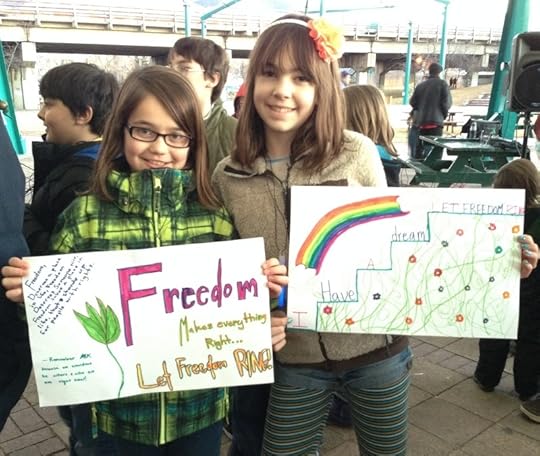
Respect Club members Simone Fielding and Alice Petasek
Missoula knows how to celebrate.
As the sunlight began to wane on the cusp of the Martin Luther King Jr. Day Celebration, Coach Wayne Tinkle, University of Montana Grizzly basketball players, and others enjoyed cups of steaming hot chocolate. Members of elementary and middle school Respect Clubs passed out glow sticks as young and old gathered at Caras Park for the Youth Voices: Speaking Up and Speaking Out rally.
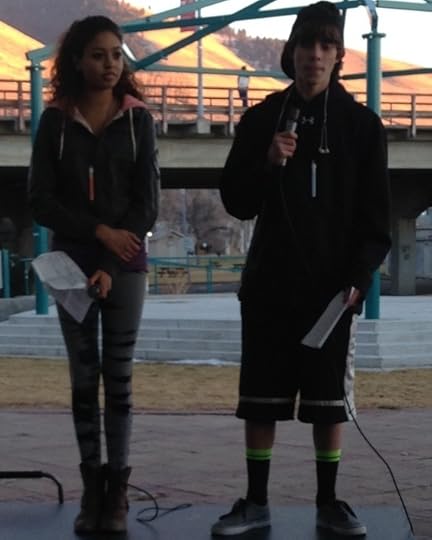
Emcees McKayla Hansen and Draven Roe
Respect Club’s McKayla Hansen of Sentinel High School and Draven Roe of Hellgate High School shared their stories to open the rally, then kept things rolling throughout. We were treated to wise words from Trail Bundy of UM’s Kyi-Yo Native American Student Association and Vance Home Gun of The Salish Institute, and to a song from Big Sky High School singer/songwriter Jessy Stobart. Following the rally, many in attendance took part in a lighted march to Saint Paul Lutheran Church for the culmination of the evening’s festivities.
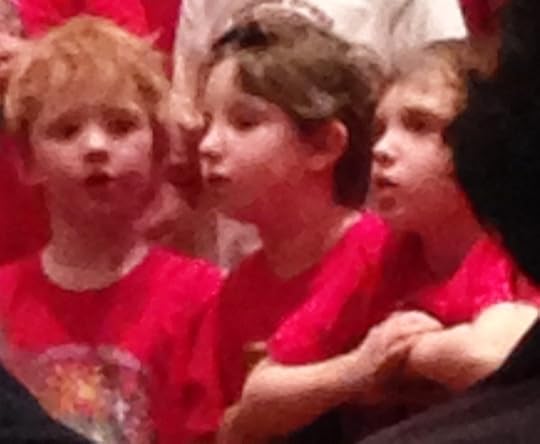
Three young members of the Lewis and Clark Peace Choir
A poignant slide slow played as hundreds filed in—filling every seat and spilling into the aisles—to honor the legacy of Dr. King. Montana’s original blues artist, Andre’ Floyd, and the Lewis and Clark Peace Choir sang for us. The winners of the nineteenth annual Martin Luther King Jr. art and essay contest were introduced, too. Preschool- through high school-aged students were asked to respond to this MLK quote: “If you can’t fly, run. If you can’t run, walk. If you can’t walk, crawl. But by all means, keep moving.”
In addition to being recognized at the Community Celebration, the top three finishers in each category and age bracket had their winning entries published in the Missoulian. A shout out to Hellgate High School for sweeping the ninth-twelfth grade contest.
We listened to thought-provoking words from Pastor Chris Flohr, Jamar Galbreath, Floyd Kumahlo and Dr. Paul Gordon Lauren. In the keynote address, Dr. Lauren said that fifty years ago, he did not envision we’d elect an African American president one day. Not once, but twice. Nor did he imagine he’d see the day when his preschool-aged grandson would bring home a picture of Dr. King. When asked about the picture, his grandson replied, “That’s King Arthur. He saved the world.”
Would that our world was saved. Changed, yes, but Dr. Martin Luther King Jr.’s work remains unfinished. As the evening’s program came to a close and we prepared to go downstairs to share a community meal, our voices blended in unison as together we sang:
We shall overcome, we shall overcome,
We shall overcome someday;
Oh, deep in my heart, I do believe,
We shall overcome someday.
We’ll walk hand in hand, we’ll walk hand in hand,
We’ll walk hand in hand someday;
Oh, deep in my heart, I do believe,
We’ll walk hand in hand someday.
We shall live in peace, we shall live in peace,
We shall live in peace someday;
Oh, deep in my heart, I do believe,
We shall live in peace someday.
 Tags: Andre' Floyd, Dr. Martin Luther King Jr., Kyi-Yo, Lewis and Clark Peace Choir, Respect Club, The Salish Institute
Tags: Andre' Floyd, Dr. Martin Luther King Jr., Kyi-Yo, Lewis and Clark Peace Choir, Respect Club, The Salish InstituteDel.icio.us


TweetThis

Digg

StumbleUpon

Comments: 0 (Zero), Be the first to leave a reply!You might be interested in this:
 2013 Montana Festival of the Book
2013 Montana Festival of the Book Forty Years Later
Forty Years Later Thank You for Your Service
Thank You for Your Service World Book Night
World Book Night Nanny on the Run is Launched!Copyright © Karen Buley [Missoula's Martin Luther King Jr. Day Celebration], All Right Reserved. 2014.
Nanny on the Run is Launched!Copyright © Karen Buley [Missoula's Martin Luther King Jr. Day Celebration], All Right Reserved. 2014.December 15, 2013
Forty Years Later
It is the time of year when many high school seniors are immersed in college applications. Some have ideas about what they want to pursue after graduation. Others do not.
As I worked my way through my final year of high school forty years ago, I knew I wanted to follow in my mother’s footsteps and become a nurse. A Butte Central classmate, Janet Finn, was planning to study pre-med. Another classmate, Leah Joki, had plans to undertake a fifth year of high school in Belgium, then come back and become a film critic. None of us envisioned that, years later, we would be authors.
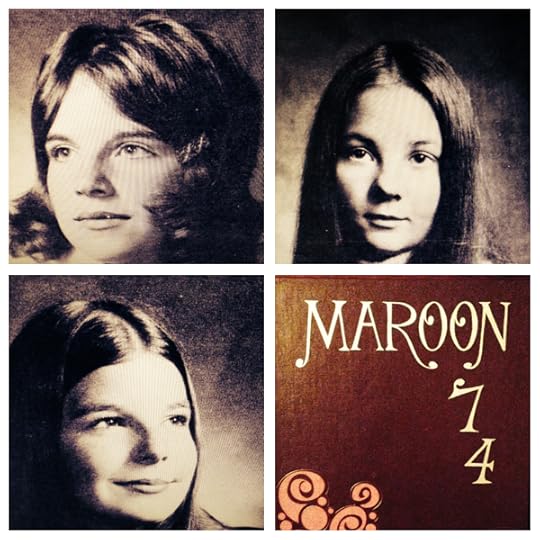
1974 Butte Central Classmates Janet Finn, Leah Joki, and Karen Antonietti.
Last month, the three of us took a road trip back to our roots to read from our most recent works. We read at the Butte-Silver Bow Public Archives at noon and at the Finlen Hotel Copper Bowl Ballroom that evening.
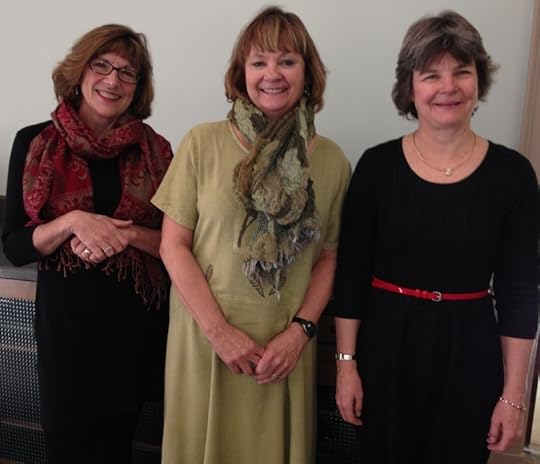
Janet Finn, Leah Joki, and Karen Buley.

MINING CHILDHOOD: GROWING UP IN BUTTE, 1900-1960; JUILLIARD TO JAIL; NANNY ON THE RUN.

Janet, Karen and Leah signing books at the Butte-Silver Bow Public Archives.
Our audiences were a mix of people we knew and people we didn’t; of folks with longtime Butte ties and relative newcomers. At our evening reading, a three-generation family sat in the front row. The grandmother had penned a memoir about growing up in China and the Philippines during WW II. The dad, a Golden Gloves boxer, had coached prison inmates in the sport. The mom had worked as a nurse at Saint Patrick Hospital in Missoula, and their daughters—one in college and one in high school—aspired to become an actor and a writer.
Years have passed since Janet, Leah and I were the ages of those girls, and our lives are different than what we had imagined they would be. Janet teaches in social work, women’s studies, and international development studies at the University of Montana. Leah received an MFA in acting from the University of Montana last spring. She recently wrote and performed her one-woman show, PRISON BOXING, at Missoula’s Downtown Dance Collective. I, after a long and fulfilling nursing career, am working as a library media assistant in a Missoula high school. We all have works in progress.
To the girls who were seated in the front row at the Copper Bowl Ballroom, best of luck as you pursue your dreams. To Leah and Janet, our high school English teachers would be proud.
 Tags: authors, books, Butte, Janet Finn, Juilliard to Jail, Leah Joki, Mining Childhood, mothers, Nanny on the Run, nurses, reading
Tags: authors, books, Butte, Janet Finn, Juilliard to Jail, Leah Joki, Mining Childhood, mothers, Nanny on the Run, nurses, readingDel.icio.us


TweetThis

Digg

StumbleUpon

Comments: 2 comments on this itemYou might be interested in this:
 Festival of the Dead: a Time to Remember
Festival of the Dead: a Time to Remember A New Job!
A New Job! World Book Night
World Book Night Happy Library Lovers' Month
Happy Library Lovers' Month Official Pub Date!Copyright © Karen Buley [Forty Years Later], All Right Reserved. 2013.
Official Pub Date!Copyright © Karen Buley [Forty Years Later], All Right Reserved. 2013.November 20, 2013
Festival of the Dead: a Time to Remember
My first visit to a mortuary was when I was eleven years old. My best friend Re-Re and I detoured to Duggan Dolan Mortuary on our way home from school one afternoon. Our former classmate, Judy Z., had passed away, and we wanted to say goodbye.
Our parents hadn’t wanted us to go—had forbidden us, if my memory serves me correctly—so it was a clandestine mission as we turned left instead of continuing down Washington Street after leaving school. We were a stealthy pair in our Catholic school uniforms, swallowing our guilt when we passed our church en route to Duggan Dolan.
As we ascended the mortuary stairs, the door opened inward. Unable to see who had watched our arrival from behind the curtained glass, we exchanged glances. Our resolve was firm—we were not going to turn and run. We wanted to say goodbye. We entered the foyer, where a solemn, dark-suited man greeted us from behind the door. “You’re here to see Judy?” he asked.
We nodded, too afraid to speak.
“She’s straight ahead.”
We gingerly made our way through the foyer and to the front of the room. It was empty, except for Judy. Re-Re and I knelt on the adjoining kneeler and surveyed our friend. She looked peaceful and warm, cocooned in white satin. Wearing a pastel chiffon dress, a rosy blush on her cheeks and lips, she was beautiful. Gone were any signs of asthma—the disease that had ravaged her body, causing so many absences that Judy had become our sisters’ classmate as she repeated third grade. Re-Re and I offered silent prayers, then breathed our goodbyes.
We managed to retreat to the foyer, sign the guest book, pass the dark-suited man, and get out the door before bursting into tears. We detoured again, backtracking toward school and its neighboring convent. “None of the boys even came to say goodbye,” we cried to Sister Agnes Marie.
Her reply was soothing, and we left, feeling somewhat consoled. A block later, we took refuge in the alley of the abandoned hospital across the street from my home. “We’ll probably never see her again,” I said, sobs choking my words.
Re-Re agreed. Through our tears, we speculated that our defiance and previous acts of wickedness might route us to hell, rather than to heaven where we were certain Judy resided.
I don’t remember my parents’ reaction when they learned that I had gone to see Judy, but I was reminded of my introduction to death during Missoula’s recent Festival of the Dead Parade. Old and young gathered, some costumed and painted, others not, to honor and remember those who have passed, and to celebrate life.
Thank you, Bev Glueckert and Mike DeMeng, for your vision twenty-one years ago. Thank you, Missoula, for continuing to celebrate life and death each November.

 Tags: death, Duggan Dolan Mortuary, festivals, goodbyes, life
Tags: death, Duggan Dolan Mortuary, festivals, goodbyes, lifeDel.icio.us


TweetThis

Digg

StumbleUpon

Comments: 0 (Zero), Be the first to leave a reply!You might be interested in this:
 Our Introduction to the Big Sky Documentary Film Festival
Our Introduction to the Big Sky Documentary Film Festival Thank you, YouTube
Thank you, YouTube Powwows Throughout the Years
Powwows Throughout the Years World Book Night 2013Copyright © Karen Buley [Festival of the Dead: a Time to Remember], All Right Reserved. 2013.
World Book Night 2013Copyright © Karen Buley [Festival of the Dead: a Time to Remember], All Right Reserved. 2013.Tweet













